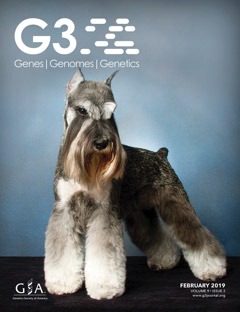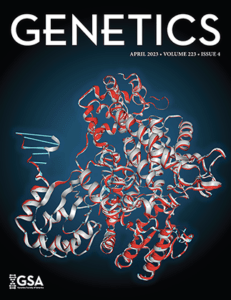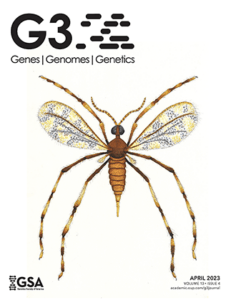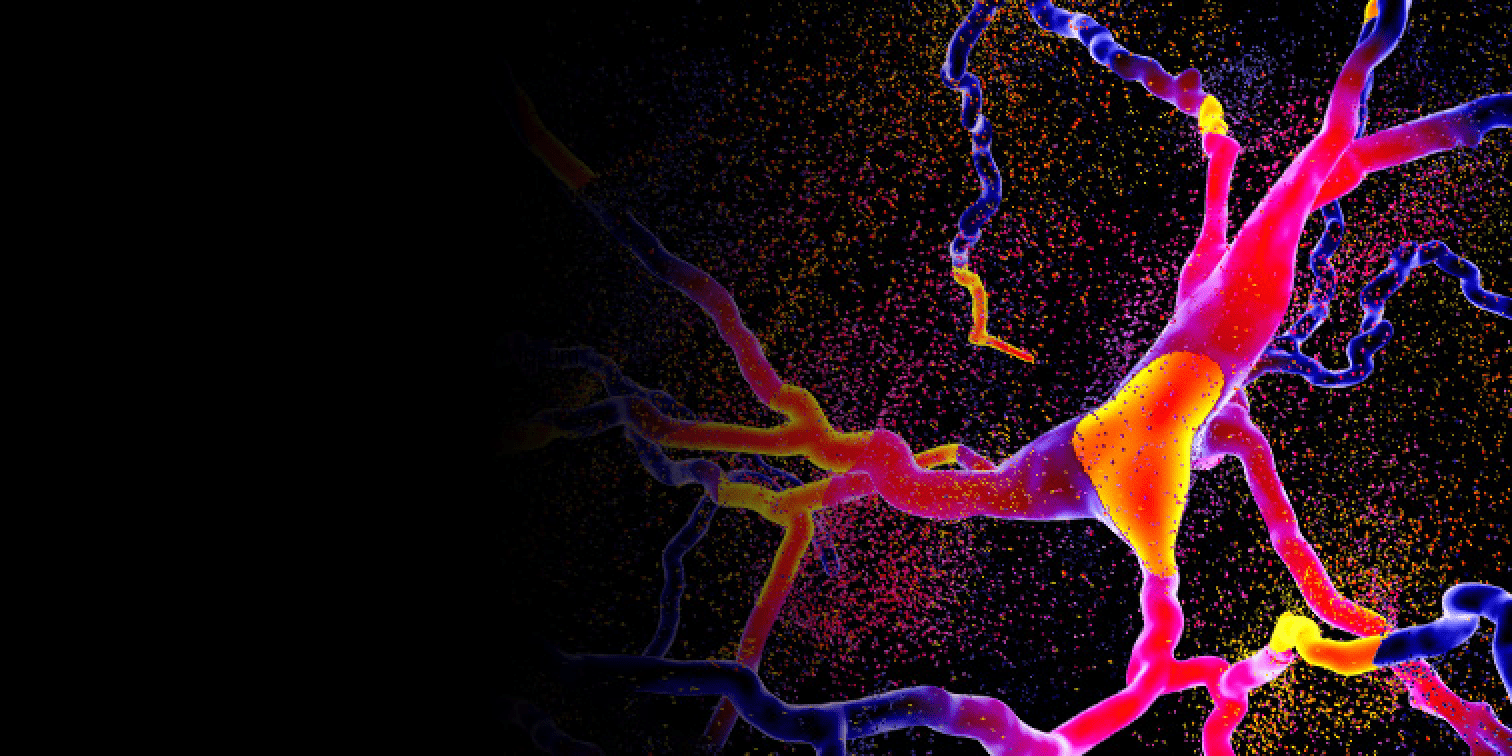Thank you for visiting the GSA booth.
We’re glad you stopped by to learn about the Genetics Society of America and our journals, conferences, and career development programming. Browse this page for easy access to the things we talked about.
Become part of GSA.
The Genetics Society of America is an international community of scientists who use the tools of genetics and genomics in our research.
Around half of our members are students and postdocs from more than 50 countries. These scientists hail from a wide range of disciplines— including cell biology, physiology, biochemistry, biophysics, neuroscience, developmental biology, evolutionary biology, and more.
GSA’s mission is to advance biological research by supporting professional development of scientists, communicating scientific advancements and fostering collaboration, and advocating for science and scientists. GSA achieves this through its various programming, most notably conferences focused on model organisms, and two peer-reviewed journals, GENETICS and G3: Genes|Genomes|Genetics.
Publish with the GSA Journals.
The GSA Journals are peer-reviewed, peer-edited, and published in partnership with Oxford University Press.
GENETICS publishes high-quality genetics and genomics research that expands scientific boundaries—we’ve been building the field since 1916. With its broad readership, rich history, and responsive editors, GENETICS brings the latest in publishing innovations to the communities it serves. We invite you to submit your research and discover the fast turnaround times and helpful review process for yourself.
Explore GENETICSGet your useful data out into the world by publishing in G3: Genes|Genomes|Genetics. G3 publishes high quality foundational research, particularly studies that generate useful genetic information, such as mutant screens, single gene studies, genome maps, genome sequence data, GWAS and QTL studies, software, data resources, and new methods. The Editorial Board of G3 believes that rapid dissemination of such data lays the foundation for many important insights.
Explore G3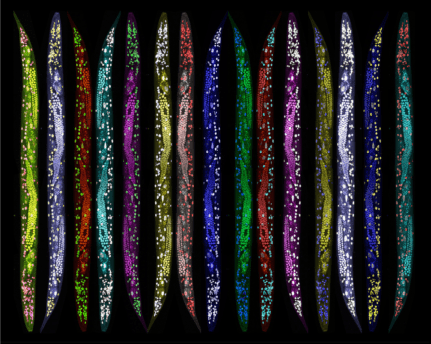
Wormbook at GENETICS
In March 2016, GENETICS launched WormBook: a comprehensive compendium of review articles presenting the current state of knowledge in C. elegans research. WormBook articles span the breadth of the biology, genetics, genomics, and evolution of C. elegans and are actively being published.
Explore Worm Papers at the GSA Journals
Just published in GENETICS
- A Twist-Box domain of the C. elegans Twist homolog, HLH-8, plays a complex role in transcriptional regulation
- Rapid generation of Caenorhabditis elegans single-copy transgenes combining recombination-mediated cassette exchange and drug selection
- Tissue-specific chromatin-binding patterns of Caenorhabditis elegans heterochromatin proteins HPL-1 and HPL-2 reveal differential roles in the regulation of gene expression
- Transcriptome profiling of the Caenorhabditis elegans intestine reveals that ELT-2 negatively and positively regulates intestinal gene expression within the context of a gene regulatory network
- Sensitized piRNA reporter identifies multiple RNA processing factors involved in piRNA-mediated gene silencing
- daf-42 is an evolutionarily young gene essential for dauer development in Caenorhabditis elegans
- A primary microcephaly-associated sas-6 mutation perturbs centrosome duplication, dendrite morphogenesis, and ciliogenesis in Caenorhabditis elegans
Highly cited in GENETICS
- The Genetics of Caenorhabditis elegans
- The DNA of Caenorhabditis elegans
- Nondisjunction mutants of the nematode Caenorhabditis elegans
- Egg-laying defective mutants of the nematode Caenorhabditis elegans
- Identification and Characterization of 22 Genes That Affect the Vulval Cell Lineages of the Nematode Caenorhabditis elegans
- A mutation in the age-1 gene in Caenorhabditis elegans lengthens life and reduces hermaphrodite fertility
- Rates of spontaneous mutation
- Two Pleiotropic Classes of daf-2 Mutation Affect Larval Arrest, Adult Behavior, Reproduction and Longevity in Caenorhabditis elegans
- Creation of Low-Copy Integrated Transgenic Lines in Caenorhabditis elegans
- Genetic Analysis of Tissue Aging in Caenorhabditis elegans: A Role for Heat-Shock Factor and Bacterial Proliferation
Just published in G3: Genes|Genomes|Genetics
- Experimental considerations for study of C. elegans
- FLInt: single shot safe harbor transgene integration via Fluorescent Landmark Interference
- Cryptic genetic variation of expression quantitative trait locus architecture revealed by genetic perturbation in Caenorhabditis elegans
- Isolation and molecular identification of nematode surface mutants with resistance to bacterial pathogens
Highly cited in G3: Genes|Genomes|Genetics
- Large-Scale Screening for Targeted Knockouts in the Caenorhabditis elegans Genome
- Multigenic Natural Variation Underlies Caenorhabditis elegans Olfactory Preference for the Bacterial Pathogen Serratia marcescens
- Rapid Evolution of Phenotypic Plasticity and Shifting Thresholds of Genetic Assimilation in the Nematode Caenorhabditis remanei
- A New Dataset of Spermatogenic vs. Oogenic Transcriptomes in the Nematode Caenorhabditis elegans
- A Powerful New Quantitative Genetics Platform, Combining Caenorhabditis elegans High-Throughput Fitness Assays with a Large Collection of Recombinant Strains
- Aberrant Activation of p38 MAP Kinase-Dependent Innate Immune Responses Is Toxic to Caenorhabditis elegans
- Reliable CRISPR/Cas9 Genome Engineering in Caenorhabditis elegans Using a Single Efficient sgRNA and an Easily Recognizable Phenotype
- Intricate and Cell Type-Specific Populations of Endogenous Circular DNA (eccDNA) in Caenorhabditis elegans and Homo sapiens
- CRISPR/Cas9 Methodology for the Generation of Knockout Deletions in Caenorhabditis elegans
- CeMbio – The Caenorhabditis elegans Microbiome Resource
The Allied Genetics Conference 2024
March 6–10, 2024 | Gaylord National Resort & Convention Center | Metro Washington, DC
TAGC is a unique GSA conference that brings together scientists from multiple international biological research communities to share cutting-edge science, foster new collaborations, and strengthen existing relationships. With an exciting mix of sessions that focus on advances in genetics and genomics in a variety of research organisms, TAGC 2024 is designed to shape the big picture, include diverse voices, and showcase the fundamental unity of biology—all while providing attendees the chance to spend time with old friends and valued colleagues from around the world.
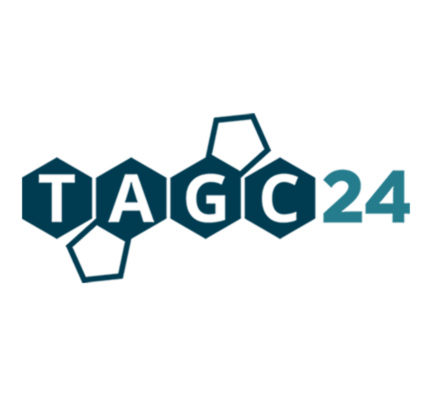
Develop your skills.
GSA helps scientists develop their skills and achieve their career goals. We design programs and initiatives to provide experience, training, mentorship, and community.
Early Career Leadership Program
Develop your skills, join a thriving network, and demonstrate your abilities by participating in the GSA’s Early Career Leadership Program! In this online program, participants work in teams to propose, develop, and implement initiatives that address unmet needs for the early career scientist community. Participants have the opportunity to work on their writing skills, which includes the option to take a writing workshop tailored for the needs of early career scientists. Early career leaders complete the program with new skills, a network of peers and mentors, and concrete deliverables that demonstrate their abilities.
Applications will reopen in Fall 2023.
Peer Review Training Program
Get real-world peer review training and experience by participating in this innovative program! Peer reviewers are vital to science. Yet early career scientists in our field rarely receive formal training in how to be a good reviewer. GSA and the GSA Journals are addressing this gap with a program that gives early career members real-world peer review experience. Participants will receive online training and advice from GENETICS and G3 editors as they become reviewers for manuscripts submitted to the journal. Early career scientists from anywhere in the world are encouraged to apply. We particularly welcome applications from members who lack opportunities to receive peer review training in their home labs or departments.
Senior graduate students, postdocs, and early career scientists within 7-years of having earned their PhD are invited to apply. Applicants should have published at least one peer-reviewed manuscript, preferably as the first author.
Participants entering the program in 2024 will review for both GENETICS and G3. Applications will open in August 2023.
Frequently Asked Questions
What does it cost to publish in the GSA Journals?
What are the benefits of a GSA membership?
How much does a GSA membership cost?
What does GSA offer for undergraduate students?
Do you have teaching materials available?
How can I tell if my work is a good fit for the GSA Journals?
How long does it take to publish at paper at the GSA Journals?
Statistical Genetics in Human Populations
GENETICS has long stood at the center of the discussion around appropriate methodology in the analysis of complex traits. From the initial mapping paper (Lander and Botstein 1989) to the critical landmark structure paper (Pritchard et al. 2000), GENETICS is not afraid to tackle hard problems and to encourage authors to consider challenging aspects of the important and difficult task of understanding complex traits in humans. This small sample of papers highlights works that both explain and bring perspective to problems like missing heritability (Stranger et al. 2011) and how methods for analyzing complex traits in different systems are interconnected (Wray et al. 2019).
Pritchard, Stephens, and Donnelly launched a field with their 2000 paper introducing the software package structure. This tool provided a practical solution to the intractable problem of population structure in genome-wide association studies (GWAS). In demonstrating what was possible, they inspired additional practical and elegant solutions to one of the fundamental challenges in GWAS, including approaches that allow for multilocus genotype data for linked loci and correlated allele frequencies (Falush et al. 2003) and increasing speed (Raj et al. 2014).
GENETICS has also been a leader in encouraging practical implementations of sophisticated Bayesian approaches (Beaumont et al. 2002, Foll and Gaggiotti 2008, Pérez-Rodríguez and de los Campos 2022, Qu et al. 2023, Chakraborty and Rannala 2023).
More on Statistical Genetics from the GSA Journals:
- Anderson EC, Thompson EA. 2002. A Model-Based Method for Identifying Species Hybrids Using Multilocus Genetic Data. Genetics. 160(3):1217–1229. doi:10.1093/genetics/160.3.1217.
- Beaumont MA, Zhang W, Balding DJ. 2002. Approximate Bayesian Computation in Population Genetics. Genetics. 162(4):2025–2035. doi:10.1093/genetics/162.4.2025.
- Biddanda A, Steinrücken M, Novembre J. 2022. Properties of 2-locus genealogies and linkage disequilibrium in temporally structured samples. Coop G, editor. Genetics. 221(1):iyac038. doi:10.1093/genetics/iyac038.
- Boitard S, Schlötterer C, Futschik A. 2009. Detecting Selective Sweeps: A New Approach Based on Hidden Markov Models. Genetics. 181(4):1567–1578. doi:10.1534/genetics.108.100032.
- Booker WW, Ray DD, Schrider DR. 2023. This population does not exist: learning the distribution of evolutionary histories with generative adversarial networks. Barton N, editor. GENETICS. 224(2):iyad063. doi:10.1093/genetics/iyad063.
- Bradburd GS, Coop GM, Ralph PL. 2018. Inferring Continuous and Discrete Population Genetic Structure Across Space. Genetics. 210(1):33–52. doi:10.1534/genetics.118.301333.
- Cabreros I, Storey JD. 2019. A Likelihood-Free Estimator of Population Structure Bridging Admixture Models and Principal Components Analysis. Genetics. 212(4):1009–1029. doi:10.1534/genetics.119.302159.
- Chakraborty S, Rannala B. 2023. An efficient exact algorithm for identifying hybrids using population genomic sequences. Novembre J, editor. Genetics. 223(4):iyad011. doi:10.1093/genetics/iyad011.
- Chen C, Qi H, Shen Y, Pickrell J, Przeworski M. 2017. Contrasting Determinants of Mutation Rates in Germline and Soma. Genetics. 207(1):255–267. doi:10.1534/genetics.117.1114.
- Chenoweth SF, Visscher PM. 2009. Association Mapping in Outbred Populations: Power and Efficiency When Genotyping Parents and Phenotyping Progeny. Genetics. 181(2):755–765. doi:10.1534/genetics.108.099218.
- Choi SC, Hey J. 2011. Joint Inference of Population Assignment and Demographic History. Genetics. 189(2):561–577. doi:10.1534/genetics.111.129205.
- Chundru VK, Marioni RE, Prendergast JGD, Vallerga CL, Lin T, Beveridge AJ, SGPD Consortium, Gratten J, Hume DA, Deary IJ, et al. 2019. Examining the Impact of Imputation Errors on Fine-Mapping Using DNA Methylation QTL as a Model Trait. Genetics. 212(3):577–586. doi:10.1534/genetics.118.301861.
- Clark VJ, Ptak SE, Tiemann I, Qian Y, Coop G, Stone AC, Przeworski M, Arnheim N, Rienzo AD. 2007. Combining Sperm Typing and Linkage Disequilibrium Analyses Reveals Differences in Selective Pressures or Recombination Rates Across Human Populations. Genetics. 175(2):795–804. doi:10.1534/genetics.106.064964.
- Colbran LL, Ramos-Almodovar FC, Mathieson I. 2023. A gene-level test for directional selection on gene expression. Hahn M, editor. GENETICS. 224(2):iyad060. doi:10.1093/genetics/iyad060.
- Coop G, Witonsky D, Di Rienzo A, Pritchard JK. 2010. Using Environmental Correlations to Identify Loci Underlying Local Adaptation. Genetics. 185(4):1411–1423. doi:10.1534/genetics.110.114819.
- Corander J, Waldmann P, Sillanpää MJ. 2003. Bayesian Analysis of Genetic Differentiation Between Populations. Genetics. 163(1):367–374. doi:10.1093/genetics/163.1.367.
- Cotter DJ, Hofgard EF, Novembre J, Szpiech ZA, Rosenberg NA. 2023. A rarefaction approach for measuring population differences in rare and common variation. Ramachandran S, editor. GENETICS. 224(2):iyad070. doi:10.1093/genetics/iyad070.
- Di Rienzo A, Donnelly P, Toomajian C, Sisk B, Hill A, Petzl-Erler ML, Haines GK, Barch DH. 1998. Heterogeneity of Microsatellite Mutations Within and Between Loci, and Implications for Human Demographic Histories. Genetics. 148(3):1269–1284. doi:10.1093/genetics/148.3.1269.
- Durrant C, Mott R. 2010. Bayesian Quantitative Trait Locus Mapping Using Inferred Haplotypes. Genetics. 184(3):839–852. doi:10.1534/genetics.109.113183.
- Falush D, Stephens M, Pritchard JK. 2003. Inference of Population Structure Using Multilocus Genotype Data: Linked Loci and Correlated Allele Frequencies. Genetics. 164(4):1567–1587. doi:10.1093/genetics/164.4.1567.
- Fariello MI, Boitard S, Naya H, SanCristobal M, Servin B. 2013. Detecting Signatures of Selection Through Haplotype Differentiation Among Hierarchically Structured Populations. Genetics. 193(3):929–941. doi:10.1534/genetics.112.147231.
- Faubet P, Gaggiotti OE. 2008. A New Bayesian Method to Identify the Environmental Factors That Influence Recent Migration. Genetics. 178(3):1491–1504. doi:10.1534/genetics.107.082560.
- Fearnhead P, Donnelly P. 2001. Estimating Recombination Rates From Population Genetic Data. Genetics. 159(3):1299–1318. doi:10.1093/genetics/159.3.1299.
- Foll M, Gaggiotti O. 2008. A Genome-Scan Method to Identify Selected Loci Appropriate for Both Dominant and Codominant Markers: A Bayesian Perspective. Genetics. 180(2):977–993. doi:10.1534/genetics.108.092221.
- Fraïsse C, Sachdeva H. 2021. The rates of introgression and barriers to genetic exchange between hybridizing species: sex chromosomes vs autosomes. Charlesworth B, editor. Genetics. 217(2):iyaa025. doi:10.1093/genetics/iyaa025.
- Frichot E, Mathieu F, Trouillon T, Bouchard G, François O. 2014. Fast and Efficient Estimation of Individual Ancestry Coefficients. Genetics. 196(4):973–983. doi:10.1534/genetics.113.160572.
- Gao Z, Waggoner D, Stephens M, Ober C, Przeworski M. 2015. An Estimate of the Average Number of Recessive Lethal Mutations Carried by Humans. Genetics. 199(4):1243–1254. doi:10.1534/genetics.114.173351.
- Glassberg EC, Gao Z, Harpak A, Lan X, Pritchard JK. 2019. Evidence for Weak Selective Constraint on Human Gene Expression. Genetics. 211(2):757–772. doi:10.1534/genetics.118.301833.
- Gravel S. 2012. Population Genetics Models of Local Ancestry. Genetics. 191(2):607–619. doi:10.1534/genetics.112.139808.
- Guan Y. 2014. Detecting Structure of Haplotypes and Local Ancestry. Genetics. 196(3):625–642. doi:10.1534/genetics.113.160697.
- Haber M, Jones AL, Connell BA, Asan, Arciero E, Yang H, Thomas MG, Xue Y, Tyler-Smith C. 2019. A Rare Deep-Rooting D0 African Y-Chromosomal Haplogroup and Its Implications for the Expansion of Modern Humans Out of Africa. Genetics. 212(4):1421–1428. doi:10.1534/genetics.119.302368.
- Harney É, Patterson N, Reich D, Wakeley J. 2021. Assessing the performance of qpAdm: a statistical tool for studying population admixture. Novembre J, editor. Genetics. 217(4):iyaa045. doi:10.1093/genetics/iyaa045.
- Harris AM, DeGiorgio M. 2020. Identifying and Classifying Shared Selective Sweeps from Multilocus Data. Genetics. 215(1):143–171. doi:10.1534/genetics.120.303137.
- Harris AM, Garud NR, DeGiorgio M. 2018. Detection and Classification of Hard and Soft Sweeps from Unphased Genotypes by Multilocus Genotype Identity. Genetics. 210(4):1429–1452. doi:10.1534/genetics.118.301502.
- Hayeck TJ, Stong N, Baugh E, Dhindsa R, Turner TN, Malakar A, Mosbruger TL, Shaw GT-W, Duan Y, Ionita-Laza I, et al. 2022 Apr 6. Ancestry adjustment improves genome-wide estimates of regional intolerance. Novembre J, editor. Genetics.:iyac050. doi:10.1093/genetics/iyac050.
- Hellenthal G, Pritchard JK, Stephens M. 2006. The Effects of Genotype-Dependent Recombination, and Transmission Asymmetry, on Linkage Disequilibrium. Genetics. 172(3):2001–2005. doi:10.1534/genetics.104.039271.
- Hibbins MS, Hahn MW. 2019. The Timing and Direction of Introgression Under the Multispecies Network Coalescent. Genetics. 211(3):1059–1073. doi:10.1534/genetics.118.301831.
- Hibbins MS, Hahn MW. 2022. Phylogenomic approaches to detecting and characterizing introgression. Turelli M, editor. Genetics. 220(2):iyab173. doi:10.1093/genetics/iyab173.
- Holland D, Frei O, Desikan R, Fan C-C, Shadrin AA, Smeland OB, Andreassen OA, Dale AM. 2021. The genetic architecture of human complex phenotypes is modulated by linkage disequilibrium and heterozygosity. Zaitlen N, editor. Genetics. 217(3):iyaa046. doi:10.1093/genetics/iyaa046.
- Innan H, Zhang K, Marjoram P, Tavaré S, Rosenberg NA. 2005. Statistical Tests of the Coalescent Model Based on the Haplotype Frequency Distribution and the Number of Segregating Sites. Genetics. 169(3):1763–1777. doi:10.1534/genetics.104.032219.
- Jakobsson M, Edge MD, Rosenberg NA. 2013. The Relationship Between F ST and the Frequency of the Most Frequent Allele. Genetics. 193(2):515–528. doi:10.1534/genetics.112.144758.
- Jeong C, Nakagome S, Di Rienzo A. 2016. Deep History of East Asian Populations Revealed Through Genetic Analysis of the Ainu. Genetics. 202(1):261–272. doi:10.1534/genetics.115.178673.
- Jewett EM, Zawistowski M, Rosenberg NA, Zöllner S. 2012. A Coalescent Model for Genotype Imputation. Genetics. 191(4):1239–1255. doi:10.1534/genetics.111.137984.
- Johri P, Charlesworth B, Howell EK, Lynch M, Jensen JD. 2021. Revisiting the notion of deleterious sweeps. Genetics. 219(3):iyab094. doi:10.1093/genetics/iyab094.
- Jørsboe E, Albrechtsen A. 2022. Efficient approaches for large-scale GWAS with genotype uncertainty. Hernandez R, editor. G3 Genes|Genomes|Genetics. 12(1):jkab385. doi:10.1093/g3journal/jkab385.
- Jouganous J, Long W, Ragsdale AP, Gravel S. 2017. Inferring the Joint Demographic History of Multiple Populations: Beyond the Diffusion Approximation. Genetics. 206(3):1549–1567. doi:10.1534/genetics.117.200493.
- Käfer J, Lartillot N, Marais GAB, Picard F. 2021. Detecting sex-linked genes using genotyped individuals sampled in natural populations. Agrawal A, editor. Genetics. 218(2):iyab053. doi:10.1093/genetics/iyab053.
- Kampourakis K, Peterson EL. 2023. The racist origins, racialist connotations, and purity assumptions of the concept of “admixture” in human evolutionary genetics. Barton N, editor. GENETICS. 223(3):iyad002. doi:10.1093/genetics/iyad002.
- Kang CJ, Marjoram P. 2011. Inference of Population Mutation Rate and Detection of Segregating Sites from Next-Generation Sequence Data. Genetics. 189(2):595–605. doi:10.1534/genetics.111.130898.
- Kessner D, Novembre J. 2015. Power Analysis of Artificial Selection Experiments Using Efficient Whole Genome Simulation of Quantitative Traits. Genetics. 199(4):991–1005. doi:10.1534/genetics.115.175075.
- Kitada S, Kitakado T, Kishino H. 2007. Empirical Bayes Inference of Pairwise F ST and Its Distribution in the Genome. Genetics. 177(2):861–873. doi:10.1534/genetics.107.077263.
- Lander ES, Botstein D. 1989. Mapping mendelian factors underlying quantitative traits using RFLP linkage maps. Genetics. 121(1):185–199. doi:10.1093/genetics/121.1.185.
- Laval G, Patin E, Boutillier P, Quintana-Murci L. 2021. Sporadic occurrence of recent selective sweeps from standing variation in humans as revealed by an approximate Bayesian computation approach. Novembre J, editor. Genetics. 219(4):iyab161. doi:10.1093/genetics/iyab161.
- Li N, Stephens M. 2003. Modeling Linkage Disequilibrium and Identifying Recombination Hotspots Using Single-Nucleotide Polymorphism Data. Genetics. 165(4):2213–2233. doi:10.1093/genetics/165.4.2213.
- Liang M, Nielsen R. 2014. The Lengths of Admixture Tracts. Genetics. 197(3):953–967. doi:10.1534/genetics.114.162362.
- Lin K, Futschik A, Li H. 2013. A Fast Estimate for the Population Recombination Rate Based on Regression. Genetics. 194(2):473–484. doi:10.1534/genetics.113.150201.
- Lloyd-Jones LR, Robinson MR, Moser G, Zeng J, Beleza S, Barsh GS, Tang H, Visscher PM. 2017. Inference on the Genetic Basis of Eye and Skin Color in an Admixed Population via Bayesian Linear Mixed Models. Genetics. 206(2):1113–1126. doi:10.1534/genetics.116.193383.
- Lloyd-Jones LR, Robinson MR, Yang J, Visscher PM. 2018. Transformation of Summary Statistics from Linear Mixed Model Association on All-or-None Traits to Odds Ratio. Genetics. 208(4):1397–1408. doi:10.1534/genetics.117.300360.
- Loh P-R, Lipson M, Patterson N, Moorjani P, Pickrell JK, Reich D, Berger B. 2013. Inferring Admixture Histories of Human Populations Using Linkage Disequilibrium. Genetics. 193(4):1233–1254. doi:10.1534/genetics.112.147330.
- Lohmueller KE, Bustamante CD, Clark AG. 2009. Methods for Human Demographic Inference Using Haplotype Patterns From Genomewide Single-Nucleotide Polymorphism Data. Genetics. 182(1):217–231. doi:10.1534/genetics.108.099275.
- Martin SH, Van Belleghem SM. 2017. Exploring Evolutionary Relationships Across the Genome Using Topology Weighting. Genetics. 206(1):429–438. doi:10.1534/genetics.116.194720.
- Meisner J, Albrechtsen A. 2018. Inferring Population Structure and Admixture Proportions in Low-Depth NGS Data. Genetics. 210(2):719–731. doi:10.1534/genetics.118.301336.
- Meyer WK, Arbeithuber B, Ober C, Ebner T, Tiemann-Boege I, Hudson RR, Przeworski M. 2012. Evaluating the Evidence for Transmission Distortion in Human Pedigrees. Genetics. 191(1):215–232. doi:10.1534/genetics.112.139576.
- Milligan WR, Amster G, Sella G. 2022. The impact of genetic modifiers on variation in germline mutation rates within and among human populations. Martin G, editor. Genetics. 221(4):iyac087. doi:10.1093/genetics/iyac087.
- Montinaro F, Busby GBJ, Gonzalez-Santos M, Oosthuitzen O, Oosthuitzen E, Anagnostou P, Destro-Bisol G, Pascali VL, Capelli C. 2017. Complex Ancient Genetic Structure and Cultural Transitions in Southern African Populations. Genetics. 205(1):303–316. doi:10.1534/genetics.116.189209.
- Mott R, Fischer C, Prins P, Davies RW. 2020. Private Genomes and Public SNPs: Homomorphic Encryption of Genotypes and Phenotypes for Shared Quantitative Genetics. Genetics. 215(2):359–372. doi:10.1534/genetics.120.303153.
- Mughal MR, DeGiorgio M. 2022. Properties and unbiased estimation of F – and D -statistics in samples containing related and inbred individuals. Browning S, editor. Genetics. 220(1):iyab090. doi:10.1093/genetics/iyab090.
- Nøhr AK, Hanghøj K, Garcia-Erill G, Li Z, Moltke I, Albrechtsen A. 2021. NGSremix: a software tool for estimating pairwise relatedness between admixed individuals from next-generation sequencing data. G3 Genes|Genomes|Genetics. 11(8):jkab174. doi:10.1093/g3journal/jkab174.
- Novembre J. 2014. Variations on a Common STRUCTURE: New Algorithms for a Valuable Model. Genetics. 197(3):809–811. doi:10.1534/genetics.114.166264.
- Novembre J. 2016. Pritchard, Stephens, and Donnelly on Population Structure. Genetics. 204(2):391–393. doi:10.1534/genetics.116.195164.
- Novembre J, Barton NH. 2018. Tread Lightly Interpreting Polygenic Tests of Selection. Genetics. 208(4):1351–1355. doi:10.1534/genetics.118.300786.
- Ortega-Del Vecchyo D, Lohmueller KE, Novembre J. 2022. Haplotype-based inference of the distribution of fitness effects. Gravel S, editor. Genetics. 220(4):iyac002. doi:10.1093/genetics/iyac002.
- Osmond MM, Coop G. 2020. Genetic Signatures of Evolutionary Rescue by a Selective Sweep. Genetics. 215(3):813–829. doi:10.1534/genetics.120.303173.
- Padhukasahasram B, Rannala B. 2011. Bayesian Population Genomic Inference of Crossing Over and Gene Conversion. Genetics. 189(2):607–619. doi:10.1534/genetics.111.130195.
- Patterson N, Moorjani P, Luo Y, Mallick S, Rohland N, Zhan Y, Genschoreck T, Webster T, Reich D. 2012. Ancient Admixture in Human History. Genetics. 192(3):1065–1093. doi:10.1534/genetics.112.145037.
- Paul JS, Song YS. 2010. A Principled Approach to Deriving Approximate Conditional Sampling Distributions in Population Genetics Models with Recombination. Genetics. 186(1):321–338. doi:10.1534/genetics.110.117986.
- Paul JS, Steinrücken M, Song YS. 2011. An Accurate Sequentially Markov Conditional Sampling Distribution for the Coalescent With Recombination. Genetics. 187(4):1115–1128. doi:10.1534/genetics.110.125534.
- Pérez-Rodríguez P, de los Campos G. 2022. Multitrait Bayesian shrinkage and variable selection models with the BGLR-R package. Chesler E, editor. Genetics. 222(1):iyac112. doi:10.1093/genetics/iyac112.
- Peter BM. 2016. Admixture, Population Structure, and F -Statistics. Genetics. 202(4):1485–1501. doi:10.1534/genetics.115.183913.
- Popescu A-A, Harper AL, Trick M, Bancroft I, Huber KT. 2014. A Novel and Fast Approach for Population Structure Inference Using Kernel-PCA and Optimization. Genetics. 198(4):1421–1431. doi:10.1534/genetics.114.171314.
- Pritchard JK, Stephens M, Donnelly P. 2000. Inference of Population Structure Using Multilocus Genotype Data. Genetics. 155(2):945–959. doi:10.1093/genetics/155.2.945.
- Przeworski M. 2002. The Signature of Positive Selection at Randomly Chosen Loci. Genetics. 160(3):1179–1189. doi:10.1093/genetics/160.3.1179.
- Przeworski M. 2003. Estimating the Time Since the Fixation of a Beneficial Allele. Genetics. 164(4):1667–1676. doi:10.1093/genetics/164.4.1667.
- Ptak SE, Voelpel K, Przeworski M. 2004. Insights Into Recombination From Patterns of Linkage Disequilibrium in Humans. Genetics. 167(1):387–397. doi:10.1534/genetics.167.1.387.
- Qu J, Runcie D, Cheng H. 2023. Mega-scale Bayesian regression methods for genome-wide prediction and association studies with thousands of traits. Endelman J, editor. Genetics. 223(3):iyac183. doi:10.1093/genetics/iyac183.
- Racimo F. 2016. Testing for Ancient Selection Using Cross-population Allele Frequency Differentiation. Genetics. 202(2):733–750. doi:10.1534/genetics.115.178095.
- Racimo F, Berg JJ, Pickrell JK. 2018. Detecting Polygenic Adaptation in Admixture Graphs. Genetics. 208(4):1565–1584. doi:10.1534/genetics.117.300489.
- Raj A, Stephens M, Pritchard JK. 2014. fastSTRUCTURE: Variational Inference of Population Structure in Large SNP Data Sets. Genetics. 197(2):573–589. doi:10.1534/genetics.114.164350.
- Ralph P, Thornton K, Kelleher J. 2020. Efficiently Summarizing Relationships in Large Samples: A General Duality Between Statistics of Genealogies and Genomes. Genetics. 215(3):779–797. doi:10.1534/genetics.120.303253.
- Restifo LL. 2022. Unraveling the Gordian knot: genetics and the troubled road to effective therapeutics for Alzheimer’s disease. Kaczorowski C, editor. Genetics. 220(1):iyab185. doi:10.1093/genetics/iyab185.
- Robins C, McRae AF, Powell JE, Wiener HW, Aslibekyan S, Kennedy EM, Absher DM, Arnett DK, Montgomery GW, Visscher PM, et al. 2017. Testing Two Evolutionary Theories of Human Aging with DNA Methylation Data. Genetics. 207(4):1547–1560. doi:10.1534/genetics.117.300217.
- Rosenberg NA, Nordborg M. 2006. A General Population-Genetic Model for the Production by Population Structure of Spurious Genotype–Phenotype Associations in Discrete, Admixed or Spatially Distributed Populations. Genetics. 173(3):1665–1678. doi:10.1534/genetics.105.055335.
- Salter-Townshend M, Myers S. 2019. Fine-Scale Inference of Ancestry Segments Without Prior Knowledge of Admixing Groups. Genetics. 212(3):869–889. doi:10.1534/genetics.119.302139.
- Schraiber JG. 2018. Assessing the Relationship of Ancient and Modern Populations. Genetics. 208(1):383–398. doi:10.1534/genetics.117.300448.
- Schrider DR. 2020. Background Selection Does Not Mimic the Patterns of Genetic Diversity Produced by Selective Sweeps. Genetics. 216(2):499–519. doi:10.1534/genetics.120.303469.
- Schrider DR, Shanku AG, Kern AD. 2016. Effects of Linked Selective Sweeps on Demographic Inference and Model Selection. Genetics. 204(3):1207–1223. doi:10.1534/genetics.116.190223.
- Setter D, Ebdon S, Jackson B, Lohse K. 2022. Estimating the rates of crossover and gene conversion from individual genomes. Coop G, editor. Genetics. 222(1):iyac100. doi:10.1093/genetics/iyac100.
- Sheehan S, Harris K, Song YS. 2013. Estimating Variable Effective Population Sizes from Multiple Genomes: A Sequentially Markov Conditional Sampling Distribution Approach. Genetics. 194(3):647–662. doi:10.1534/genetics.112.149096.
- Shringarpure S, Xing EP. 2009. mStruct: Inference of Population Structure in Light of Both Genetic Admixing and Allele Mutations. Genetics. 182(2):575–593. doi:10.1534/genetics.108.100222.
- Si Y, Vanderwerff B, Zöllner S. 2021. Why are rare variants hard to impute? Coalescent models reveal theoretical limits in existing algorithms. Ramachandran S, editor. Genetics. 217(4):iyab011. doi:10.1093/genetics/iyab011.
- Sodini SM, Kemper KE, Wray NR, Trzaskowski M. 2018. Comparison of Genotypic and Phenotypic Correlations: Cheverud’s Conjecture in Humans. Genetics. 209(3):941–948. doi:10.1534/genetics.117.300630.
- Song S, Sliwerska E, Emery S, Kidd JM. 2017. Modeling Human Population Separation History Using Physically Phased Genomes. Genetics. 205(1):385–395. doi:10.1534/genetics.116.192963.
- Sousa VC, Fritz M, Beaumont MA, Chikhi L. 2009. Approximate Bayesian Computation Without Summary Statistics: The Case of Admixture. Genetics. 181(4):1507–1519. doi:10.1534/genetics.108.098129.
- Stephan W. 2019. Selective Sweeps. Genetics. 211(1):5–13. doi:10.1534/genetics.118.301319.
- Stich B, Möhring J, Piepho H-P, Heckenberger M, Buckler ES, Melchinger AE. 2008. Comparison of Mixed-Model Approaches for Association Mapping. Genetics. 178(3):1745–1754. doi:10.1534/genetics.107.079707.
- Stranger BE, Stahl EA, Raj T. 2011. Progress and Promise of Genome-Wide Association Studies for Human Complex Trait Genetics. Genetics. 187(2):367–383. doi:10.1534/genetics.110.120907.
- Taskent O, Lin YL, Patramanis I, Pavlidis P, Gokcumen O. 2020. Analysis of Haplotypic Variation and Deletion Polymorphisms Point to Multiple Archaic Introgression Events, Including from Altai Neanderthal Lineage. Genetics. 215(2):497–509. doi:10.1534/genetics.120.303167.
- Telis N, Lehmann BV, Feldman MW, Pritchard JK. 2016. A Bibliometric History of the Journal GENETICS. Genetics. 204(4):1337–1342. doi:10.1534/genetics.116.196964.
- Teshima KM, Przeworski M. 2006. Directional Positive Selection on an Allele of Arbitrary Dominance. Genetics. 172(1):713–718. doi:10.1534/genetics.105.044065.
- The Alliance of Genome Resources Consortium. 2019. The Alliance of Genome Resources: Building a Modern Data Ecosystem for Model Organism Databases. Genetics. 213(4):1189–1196. doi:10.1534/genetics.119.302523.
- Thompson EA. 2013. Identity by Descent: Variation in Meiosis, Across Genomes, and in Populations. Genetics. 194(2):301–326. doi:10.1534/genetics.112.148825.
- Verity R, Nichols RA. 2016. Estimating the Number of Subpopulations ( K ) in Structured Populations. Genetics. 203(4):1827–1839. doi:10.1534/genetics.115.180992.
- Visscher PM, Goddard ME. 2015. A General Unified Framework to Assess the Sampling Variance of Heritability Estimates Using Pedigree or Marker-Based Relationships. Genetics. 199(1):223–232. doi:10.1534/genetics.114.171017.
- Visscher PM, Goddard ME. 2019. From R.A. Fisher’s 1918 Paper to GWAS a Century Later. Genetics. 211(4):1125–1130. doi:10.1534/genetics.118.301594.
- Wakeley J, Fan W-T (Louis), Koch E, Sunyaev S. 2023 Mar 27. Recurrent mutation in the ancestry of a rare variant. Coop G, editor. GENETICS.:iyad049. doi:10.1093/genetics/iyad049.
- Wall JD, Przeworski M. 2000. When Did the Human Population Size Start Increasing? Genetics. 155(4):1865–1874. doi:10.1093/genetics/155.4.1865.
- Wilson GA, Rannala B. 2003. Bayesian Inference of Recent Migration Rates Using Multilocus Genotypes. Genetics. 163(3):1177–1191. doi:10.1093/genetics/163.3.1177.
- Wilton PR, Zaidi A, Makova K, Nielsen R. 2018. A Population Phylogenetic View of Mitochondrial Heteroplasmy. Genetics. 208(3):1261–1274. doi:10.1534/genetics.118.300711.
- Wray NR, Kemper KE, Hayes BJ, Goddard ME, Visscher PM. 2019. Complex Trait Prediction from Genome Data: Contrasting EBV in Livestock to PRS in Humans. Genetics. 211(4):1131–1141. doi:10.1534/genetics.119.301859.
- Y. C. Brandt D, Wei X, Deng Y, Vaughn AH, Nielsen R. 2022. Evaluation of methods for estimating coalescence times using ancestral recombination graphs. Barton N, editor. Genetics. 221(1):iyac044. doi:10.1093/genetics/iyac044.
- Yang Z, Li J, Wiehe T, Li H. 2018. Detecting Recent Positive Selection with a Single Locus Test Bipartitioning the Coalescent Tree. Genetics. 208(2):791–805. doi:10.1534/genetics.117.300401.
- Zeng B, Lloyd-Jones LR, Montgomery GW, Metspalu A, Esko T, Franke L, Vosa U, Claringbould A, Brigham KL, Quyyumi AA, et al. 2019. Comprehensive Multiple eQTL Detection and Its Application to GWAS Interpretation. Genetics. 212(3):905–918. doi:10.1534/genetics.119.302091.
- Zöllner S, Pritchard JK. 2005. Coalescent-Based Association Mapping and Fine Mapping of Complex Trait Loci. Genetics. 169(2):1071–1092. doi:10.1534/genetics.104.031799.



